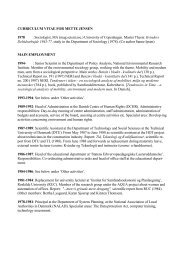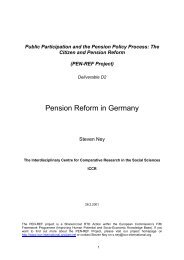The Housing Dimension of Welfare Reform - the ICCR
The Housing Dimension of Welfare Reform - the ICCR
The Housing Dimension of Welfare Reform - the ICCR
You also want an ePaper? Increase the reach of your titles
YUMPU automatically turns print PDFs into web optimized ePapers that Google loves.
4.1.2 <strong>The</strong> EUROHOME-IMPACT method to intelligent benchmarking in field<br />
<strong>of</strong> housing<br />
Let us reiterate our general approach prior to seeking its standardisation<br />
for <strong>the</strong> purposes <strong>of</strong> transferability.<br />
Our subject has been <strong>the</strong> housing dimension <strong>of</strong> welfare and welfare<br />
reform. In order to address this, we followed <strong>the</strong> following steps:<br />
1. In recognition <strong>of</strong> different frameworks <strong>of</strong> evaluation, we<br />
distinguished between (housing) policies, on <strong>the</strong> one hand, and<br />
(housing) programmes or services, on <strong>the</strong> o<strong>the</strong>r.<br />
2. When looking at housing policies, we concentrated on understanding<br />
in a comparative framework:<br />
(a) <strong>The</strong> role <strong>of</strong> ideas and policy pathways in a historical<br />
perspective – with this purpose in mind we began our project<br />
with a comprehensive review <strong>of</strong> how housing policies in<br />
various European countries have developed over time seeking<br />
to specify <strong>the</strong> opportunities and constraints <strong>the</strong>se pathways<br />
entail for contemporary reform (see section 3.3.1)<br />
(b) <strong>The</strong> effects or outcomes <strong>of</strong> housing policies at <strong>the</strong> aggregate<br />
level – in this regard it was important to examine <strong>the</strong> housing<br />
situation in different countries with <strong>the</strong> help <strong>of</strong> comparative<br />
survey data that include relevant indicators (see section 3.3.2).<br />
(c) <strong>The</strong> meaning <strong>of</strong> ‘housing integration’ as a multi-criteria<br />
concept – understanding integration in its multidimensionality<br />
also makes it to explore <strong>the</strong> strengths and weaknesses <strong>of</strong><br />
housing policies in a detailed manner and accordingly identify<br />
where reforms are mostly needed and anticipate negative or<br />
unintended consequences (see sections 3.3.3 and 3.3.4).<br />
3. <strong>The</strong> assessment <strong>of</strong> programmes or services provides insights into <strong>the</strong><br />
more direct results and outputs <strong>of</strong> social policies as well as into <strong>the</strong><br />
dynamics <strong>of</strong> exclusion and re-integration processes at <strong>the</strong> micro-level<br />
(see section 3.4):<br />
(a) <strong>The</strong> evaluation framework for social programmes or services<br />
developed by <strong>the</strong> EUROHOME-IMPACT project considered<br />
nine dimensions: relevance, external and internal coherence,<br />
effectiveness, performance, efficiency, ethics, legitimacy and<br />
transferability. Social programmes need to ‘score’ reasonably<br />
on all <strong>of</strong> <strong>the</strong>se dimensions in order to be successful.<br />
EUROHOME-IMPACT FINAL REPORT 62









